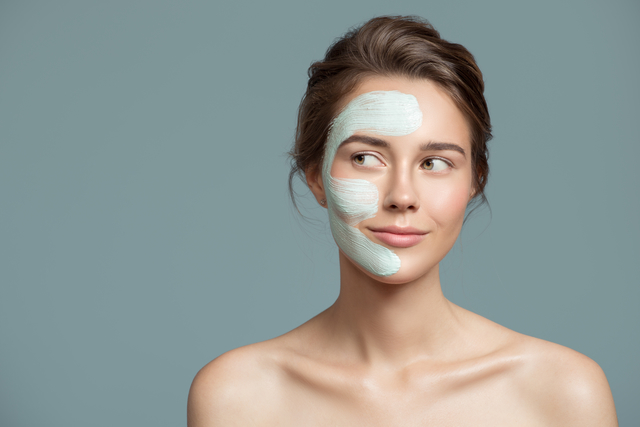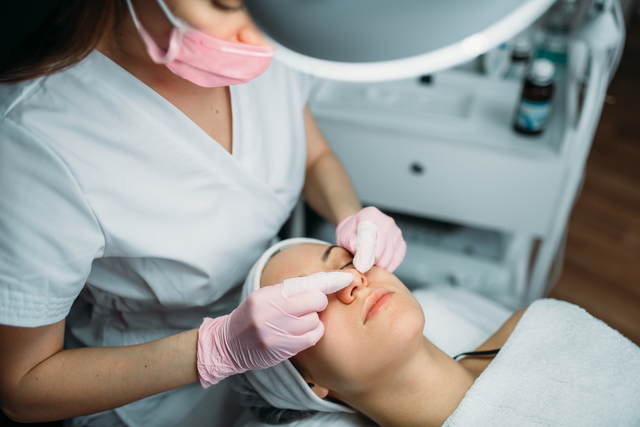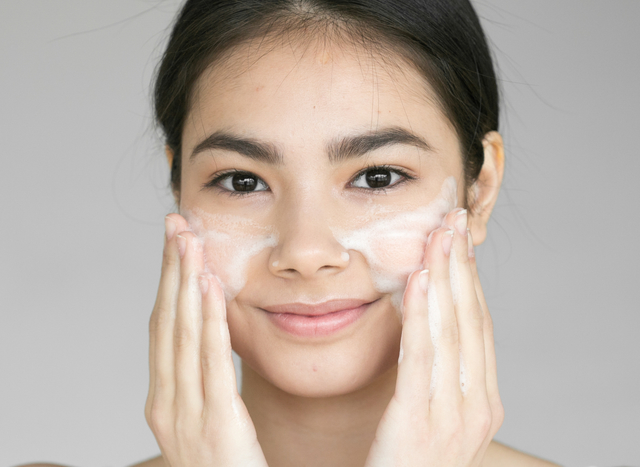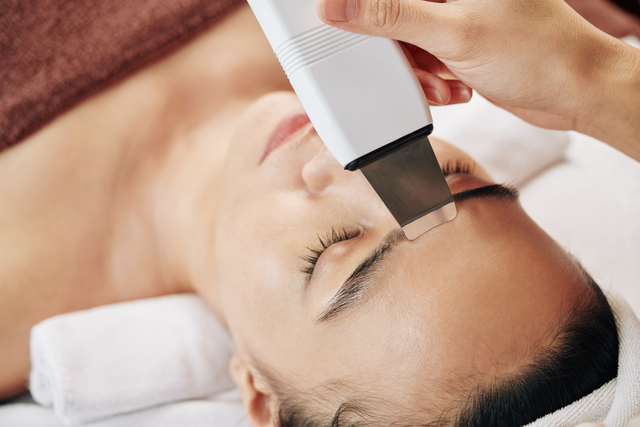Manual cleansing, as the name implies, involves manually removing any imperfections from the skin. They include, above all, open and closed blackheads. The treatment often allows you to get rid of imperfections that could not be removed during other cosmetic procedures. Manual skin cleansing can be done on different parts of the body. Usually it is a face and neck, but it can be done on the back and neckline. The time of the procedure, depending on the chosen part on the body, ranges from one to two or more hours. Its length also depends on additional, optional treatments that can be combined with manual cleansing (e.g. medical peels, cavitation peeling or microdermabrasion).
Manual facial cleansing – indications:
– Blackhead, acne,
– Pustules with various bases,
Manual cleansing – contraindications:
– Skin inflammation,
– Herpes
– Rosacea and phlegmon,
– Sensitive and vascular skin,
– Pregnancy and lactation,
– Allergic conditions
– Eye inflammation,
– Fungal and bacterial diseases
– Erosions,
– Cavernous hemangiomas,
– Tendency to develop keloids,
– Pustular acne.
Manual cleansing – effects
The treatment effectively and quickly reduces all types of skin impurities. However, it should be noted that the effects are temporary, because the procedure will not remove the problem, but only its symptoms. If the inflammatory changes are treated incorrectly, the problem may spread and even discoloration or scarring may occur. Therefore, it is worth going to the cosmetologist for the procedure, do not carry out the procedure yourself. Only non-inflammatory lesions, e.g. blackheads, piglets, may be subjected to manual cleansing.
Manual cleansing – side effects
Due to the specifics of the treatment (steam, high temperature, kneading of the skin), it may cause skin irritation, swelling, redness and pain. As a rule, these effects are not long lasting and usually disappear after 2-3 days. In the case of skin that is very sensitive to heat, redness can last up to 5 days.
The most popular facial cleansing methods include manual cleansing, mechanical and physical peels, lasers and acids.
Each of these treatments perfectly cleanses, reduces the stratum corneum, refreshes the skin.
The treatment is selected, primarily for the type of skin.
For owners of oily, acne or mixed skin, chemical peels such as salicylic, azelaic and glycolic acid will be perfect.
Salicylic acid is a β-hydroxy acid, naturally found in white willow bark. It is obtained synthetically from phenol. Shows keratoplastic activity in concentrations up to 10%. Above 10% has keratolytic, as well as comedolytic, sebostatic, anti-inflammatory and antibacterial effects.
Azelaic acid has brightening properties, regulates the functioning of the sebaceous glands, reduces the concentration of fatty acids (by inhibiting 5α-reductase). Exhibits anti-inflammatory, antioxidant, normalizes follicular keratinization. Reduces the amount of P.acnes and S.aureus. It reduces post-inflammatory and sun discoloration.
Pyruvic acid is an α-keto acid with properties similar to trichloroacetic acid (TCA). Naturally found in fermented fruit, apples and vinegar. It is present in the skin as a metabolite of carbohydrates, where it is transformed into lactic acid. Pyruvic acid works keratolytic, sebostatic and antibacterial, reduces the thickness of the stratum corneum. Penetrates into the papillary layer of the dermis (stimulates collagen and elastin synthesis). On contact with water, it is hydrolysed to lactic acid. Can be used for vascular skin. Great for acne scars.
Jessner’s solution (salicylic acid (14%) lactic acid (14%), resorcinol (14%) has strong exfoliating, antibacterial and antifungal properties. It is most often used for skin with a high level of inflammation.
Retinol accelerates cell renewal, normalizes keratinization, reduces inflammatory discoloration, and reduces scars.
Lactobionic acid is a polyhydroxy acid, containing 8 hydroxyl groups, has hygroscopic properties. It does not cause burning, itching, redness like alpha hydroxy acids. Stimulates fibroblasts for the synthesis of elastin and collagen, accelerates wound healing, strengthens the epidermal barrier, prevents transepidermal water loss, and improves skin tone.
Mandelic acid is an α-hydroxy acid, obtained from bitter almonds, cherry stones, apricots and by chemical synthesis. Lowers the pH of the skin, which protects against the development of microorganisms. It shows the strongest antibacterial properties among AHA. Regulates the functioning of the sebaceous glands, has antibacterial properties, reduces acne scars. Stimulates epidermal renewal, moisturizes, has depigmentation properties – reduces post-inflammatory discoloration. Stimulates ceramide biosynthesis. Narrows the mouth of the sebaceous glands. It is recommended to use this acid in series for long-lasting effects. Acne skin care uses a concentration of up to 10%. Medical peels help combat both the effects and causes of skin contamination, manual cleaning works only temporarily.
Glycolic acid is obtained from fermented sugar cane.
It is an acid of medium strength, does not show toxicity, has a small molecule, thanks to which it easily penetrates the stratum corneum. Glycolic acid has a wide range of activity: it inhibits the activity of phosphotransferases – enzymes that are responsible for the integrity of corneocytes, loosens cell bonds and stimulates cell renewal. Even in high concentrations, it works superficially, which is why treatments with glycolic acid should be repeated from time to time, depending on the rate of epidermal renewal. The highest concentration may cause epidermolysis within 2-7 min.
Visible effects are obtained after 4-8 treatments with an interval of 10-14 days. Before the first treatment, apply preparation creams containing 5-15% glycolic acid. Glycolic acid peels are used to reduce acne scars, discoloration and eliminate acne vulgaris. Has moisturizing and normalizing actinic keratosis. After applying this peeling, an increase in the level of ceramides in the epidermis is observed.
Lactic acid is one of the metabolites of the skin and muscle tissue. Yogurt, milk, apples, tomatoes are natural sources. Due to the asymmetrical structure of the molecule, there are isometric forms such as D-lactic acid, L-lactic acid and DL-lactic acid. Depending on the acid concentration, aqueous solutions have different pH. Lactic acid is obtained by fermenting a sugar solution by lactic acid bacteria. It has moisturizing and firming properties, improves collagen structure, increases the amount of GAG. Most often used in combination with other acids.
Malic acid is present in the skin as a metabolite of carbohydrates. Occurs in apples and quince. It is not often used in cosmetology, but it works well in home care.
For dry skin, 3-in-1 treatment – Geneo, work better. Geneo ™ treatment is a 3in1 skin care. It involves the simultaneous exfoliation, introduction of nutrients and oxygenation, causes a reaction in the body called the “Bohr effect”, as a result of which oxygen is transported to the treatment area, while strongly exfoliating the epidermis. As a result of this reaction, an ideal environment is created for the absorption of necessary active substances both during and after the procedure.
Diamond microdermabrasion – dust-free abrasion using diamond heads equipped with special filters that suck a piece of skin that is currently exfoliated.
During the procedure, erythema appears on the skin, which lasts up to several hours. The advantage of this type of cleansing is its total painlessness and the ability to perform it on pregnant and lactating people. Manual cleansing can be an addition to microdermabrasion treatment.
Microdermabrasion is controlled exfoliation of the epidermis at any depth. This is a type of mechanical peeling. It reduces acne scars, blackheads, dilated hair follicles, discoloration. By exfoliating the horny layer of the epidermis, it stimulates the skin to renew and synthesize collagen and elastin fibers. In the treatment of scars and hyperpigmentation, microdermabrasion and chemical peels are often combined for better results. Microdermabrasion is not used for ice pick scars and deep boxcar scars. A series of 5-10 treatments is recommended with intervals of several weeks. If the procedure is performed too deep, scars may occur.
Types of microdermabrasion
Diamond – epidermis abrasion using diamond heads
Corundum – alumina plays the role of an abrasive substance
Oxygen (oxybrasion) – exfoliation of the epidermis with oxygen and saline.
Contraindications to microdermabrasion include scarring, acne, fresh wounds, skin disruption, tumors, isotretinoin therapy, herpes, warts, telangiectasia, and very sensitive skin.
Vascular and sensitive skin does not like strong exfoliation, so it is best to treat it with cavitation or enzyme peeling. Cavitation peeling significantly improves the appearance of the skin by crushing calcifications, increasing metabolism inside cells and activating appropriate enzymes in them. This is one of the most delicate peels. Removing skin contaminants also stops the growth of bacteria that cause inflammation. Ultrasounds stimulate the skin to rebuild and regenerate.
Cavitation peeling contraindications:
cancers, infections and inflammation of the skin, pregnancy, breastfeeding, heart disease, thrombosis, pacemaker, wounds and broken epidermis, epilepsy.
For mature skin, the best solution will be to make an ablation laser, the treatment is not only effective in terms of exfoliation of the epidermis, but also stimulates fibroblasts to produce collagen and elastin.
Ablation laser contraindications:
– pregnancy and lactation,
– Fresh tan, solarium, spray tanning, use of the self-tanner less than 3 weeks before the procedure,
– Use of vitamin A and beta-carotene less than 3 weeks before surgery,
– Taking anticoagulants, photosensitizing antibiotics, antidepressants, retinoids less than half a year before the procedure due to the possibility of phototoxic reaction,
– Alcohol consumption less than 24 hours before the procedure,
– Cancer
– Epilepsy
Diabetes
– Pacemaker,
– Albinism or psoriasis,
– Neuropathy
There are many methods of cleansing the skin, almost all techniques can be combined – for the best results. For many years, manual cleansing was the only effective cleansing treatment on the market. Today, we have almost several dozen procedures at our disposal. All treatments should be done in series and do not forget about photoprotection and home care, which is as important as the office treatments.











